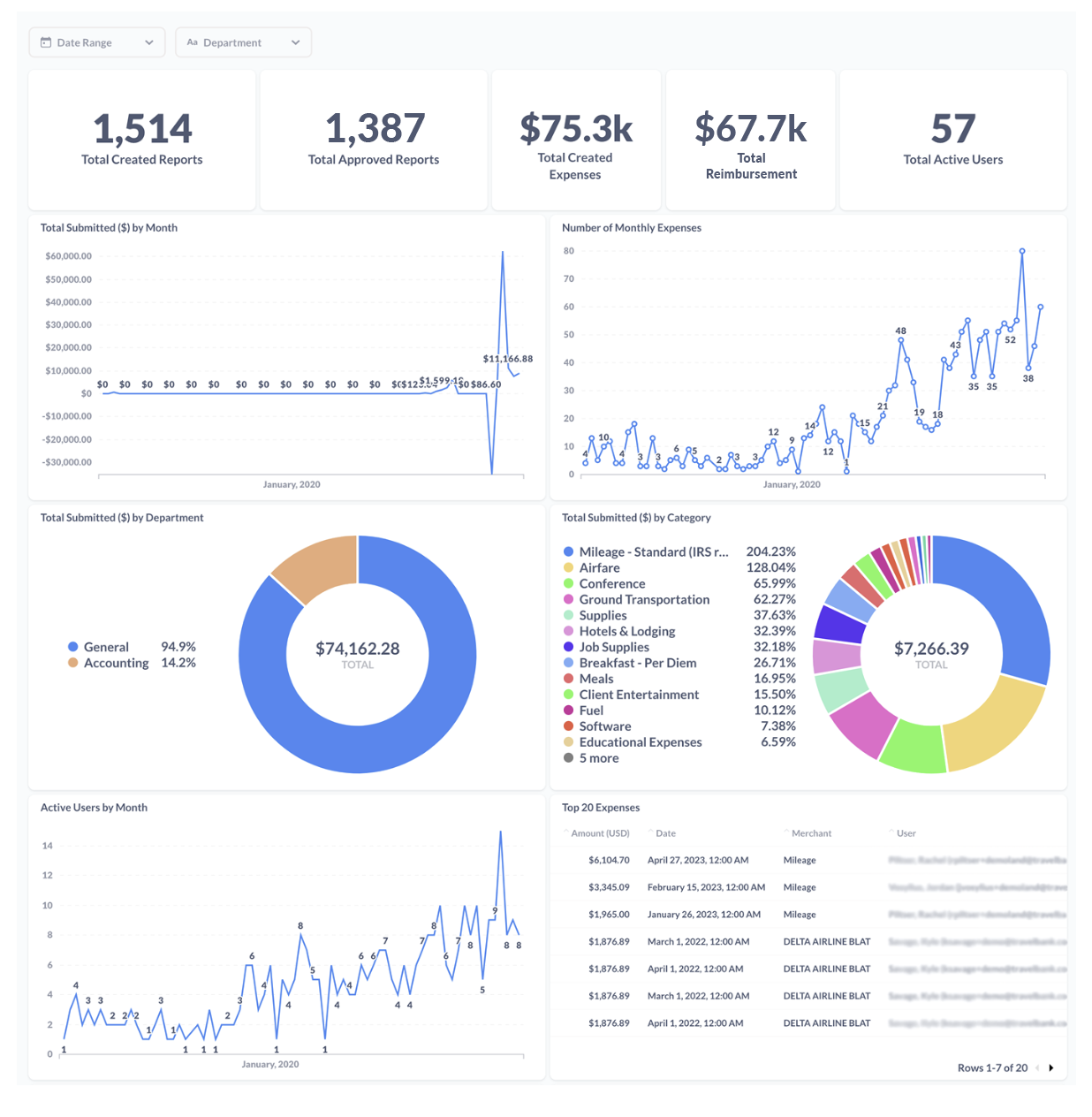Corporate travel is quickly regaining traction to pre-pandemic levels. High travel traffic and the rise in travel costs necessitate more effective travel expense management. Still, managing such expenses in a data-packed environment is easier said than done.
Data analytics solutions provide greater visibility into spend, help optimize cost structure, reinforce budgetary compliance, spot irregular spending patterns, and do so much more. This article addresses the role of data analytics in travel expense management.
Table of Contents
Eye-Opening Travel Data Analytics Trends
Still stuck on the fence regarding the roles of data analytics in expense management? Here’s how advanced technologies are rewriting the rules of corporate travel expense management as we know it:
AI-Powered Data Analytics
AI-enhanced data visualization and analysis offers greater capabilities in handling large volumes of structured and unstructured data. Organizations that adopt AI in data analytics aim to accomplish three objectives: business transformation, system modernization, and enhanced business decision-making. And with 87% of companies looking to modernize their systems, a certain increase in AI-powered data analytics can be expected.
Augmented Analytics
Less analytical business managers and executives can find great value in augmented analytics. Machine learning and artificial intelligence work in harmony to heighten the human ability to interact with data. The result is faster, more reliable, and more effective decision-making with data drawn from a human-machine effort.
Edge Computing
While still a relatively new paradigm, edge computing allows organizations to process data “closer to home.” Or, closest to where it’s generated. Edge computing incorporates a broad spectrum of networks and devices, enabling faster, more efficient data collection and processing with low-latency connectivity and secure platforms.
Understanding the Power of T&E Analytics
Analytics help businesses attain a deeper understanding of their travel program, but the benefits go far beyond minimizing manual errors.
One way analyzing travel data streamlines corporate travel is by reducing the costs of travel. As global travel costs soar above record levels, businesses need to stay vigilant about company resource usage to maintain profitability. Metrics such as trip frequency, duration, flight, and repeat accommodation costs can be analyzed better with data analytics tools to help reform the company’s travel program.
Travel expenses and budgetary allocations, too, can benefit from the assurance that comes with accurate data. Finance can rely on data analytics to ensure that the company’s financial framework remains sanctified, with accurate (and acceptable) travel expenses. In particular, travel managers can tap into predictive analysis and anticipate future expenses based on historical data.
>> Related: What Does T&E Look Like in 2025? <<
To improve vendor relationships, data analytics further provides insights into the quality of service offered by a diverse group of vendors. This includes a detailed breakdown of the expenses incurred with various providers and finding cost-effective alternatives.
How Does T&E Analytics Work?
Travel and expense analytics coordinates between several systems: from finance to compliance, and booking. Travel and expense analytics links with several data sources like credit card statements, invoices, bank statements, expense reports, and the general ledger for a well-rounded performance overview. The data thereof provides a more comprehensive summary of the company’s expenses in travel, particularly car rental, airfare, and hotel bookings.
Popular T&E Analytics Tests
It is estimated that T&E expenses account for 8 to 12 percent of the average company’s total budget. Travel managers are urged to keep close attention to the following datasets in regard travel expense management:
- Vendor analysis – Travel vendors; i.e. airlines, ground transport, hotel chains, and accommodation providers all offer different terms for corporate clients. Summarize transactions with merchants to gain insight into spending behavior and identify alternative and cost-effective travel vendors.
- Top spenders – Sales and marketing accounts for a significant portion of traveling employees. High-caliber analysis of top spenders reveals inconsistent patterns within frequently traveling employee behavior. Analyzing the data from your travel expense management tool further reveals potential savings areas hidden from the human eye.
- Duplicate transactions test – For companies that rely on manual processes for data gathering and analysis, duplicate transactions remain a significant challenge. A 2023 SAP Concur report revealed that businesses incur losses of up to $12,000 monthly from duplicate transactions. As such, identify and reconcile identical transactions to streamline reporting.
- Out-of-pocket expense analysis – Parking and cash tips account for much of the out-of-pocket expenses. Usually, out-of-pocket expenses do not necessarily need receipts as proof of purchase as they do not reach the threshold set out in your travel policy. A comprehensive analysis identifies instances where these claims are more than average and where employees use funds for their personal expenses.
Fraud remains a growing menace in the travel industry. According to the Association of Certified Fraud Examiners (ACFE), worldwide losses from fraud increased to $1.03 trillion last year. That translates to 5 percent of corporate revenue. Unmasking duplicate transactions and reinforcing your travel policy is therefore an essential part of business.
Auditing Travel Expenses With Data Analytics
There is no doubt about the immense value business corporate travel brings to businesses around the world; sales and marketing create new revenue opportunities, while consultants build new professional connections.
Auditing travel expenses with data analytics adds the following benefits to your travel program:
Debunk Controversial Expenses
Unnecessary flights, split transactions, and extended hotel accommodation are expenditures that could be hidden in the figures. Anomalous user behavior can be detected by your travel and expense management platform. Incorporating non-compliance, vendor fraud, and employee collusion unearths questionable transactions, enabling travel managers to set up measures to prevent recurrence in the future.
Reinforcing Vendor and Employee Compliance
Corporate clients often have their preferred vendors. Miscommunication may lead employees astray to vendors not pre-qualified by the company, further leading to unnecessary purchases. Non-contract suppliers can be costly to the business if no prior negotiations have been held to negotiate for more budget-friendly services.
Monitoring expenses with analytics helps crack down on payments made to unauthorized vendors. As travel managers double down on cost savings, priority attention should be given to compliance with the company’s travel policies.
Consolidate and Integrate Diverse Data Sources
For cross-regional organizations, maintaining clear oversight of the diverse data sources presents yet another challenge, further raising administrative and analytical costs. For instance, where unlimited payment options are supported, auditors would have to review all the transactions through the various payment options.
Data analytics provides deep insights into the company’s overall spending. By consolidating the discrete data sources available, travel managers can better understand employee spending patterns across different regions.
Spot and Fix Mistakes in Error-Ridden Manual Processes
Data analytics help identify and eliminate errors such as duplicate payments and omitted transactions. While entirely eliminating manual processes does sound far-fetched, streamlining the company’s travel expense, reconciling redundancies, and figuring out the root gaps or inconsistencies in the workflow enables finance to stay on top of the company’s travel budget.
In essence, taking an analytical approach to each decision has led companies to benefit from data-driven visibility. Data-backed decisions remain one of the top analytics trends because they explain occurrences and reasons why they took place in an organization. These decisions improve the effectiveness and efficiency of a company.
Conclusion
Managing travel expenses is, without a doubt, a challenging endeavor without the right tools. With TravelBank, travel managers can relish the benefits provided by greater visibility into the travel program, and the greater efficiency supported by automated travel expense management processes. Overall, gaining data visibility with TravelBank helps in making smarter decisions that will boost productivity within the organization.
FAQs
What is a data analytics journey?
The data analytics journey is the process of extracting insights and valuable information from raw data. It involves several stages, starting with data collection and preparation. Once the data is gathered, it is then analyzed using various statistical and analytical techniques. During this stage, patterns, trends, and correlations are discovered, providing important insights that can drive decision-making and problem-solving.
Do data analysts get to travel?
Data analysts do not typically get to travel extensively for their jobs. Most of their work involves analyzing data and presenting findings to their team or clients. This can be done remotely or in an office setting. However, there may be some instances where data analysts may need to travel for conferences or meetings with clients. These opportunities to travel are usually limited and not a regular part of their job.
What are the challenges in traditional travel and expense management?
Insufficiently defined travel policies and poor communication contribute to the most significant challenges experienced in traditional travel and expense management. Employees often have to keep physical receipts, fill out expense reports, and wait for approval before being reimbursed, leading to delays and frustration.
What types of data do airlines collect?
Airlines collect a wide range of data to improve their operations and enhance the customer experience. They collect data on passenger demographics, including age, gender, and nationality, to better understand their customer base and tailor services accordingly.






